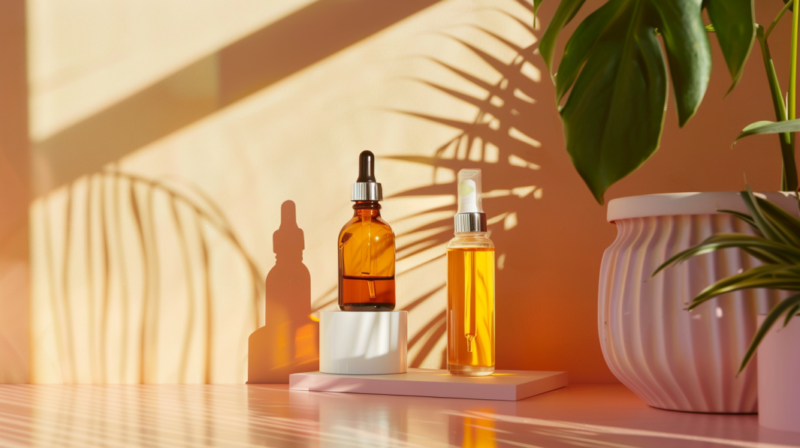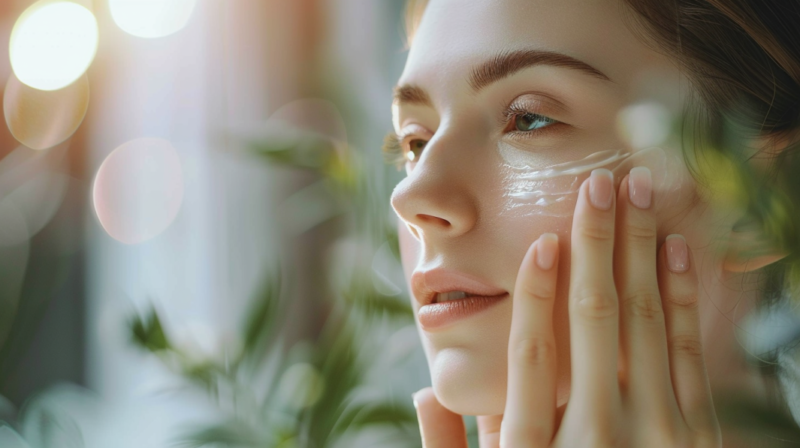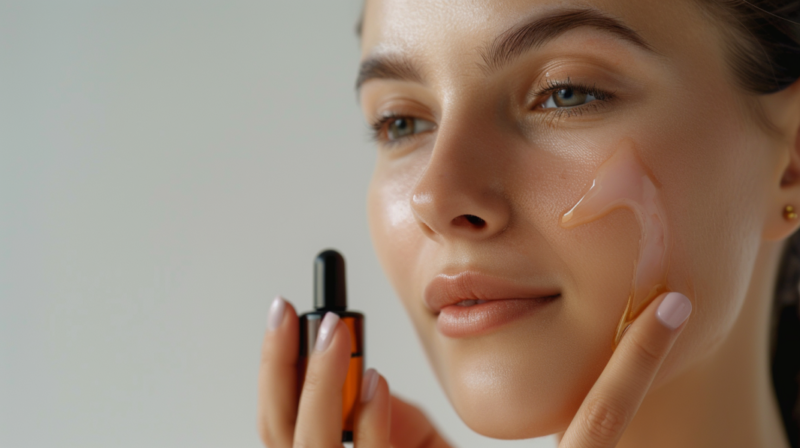Yes, you can use lactic acid and retinol together, but it’s essential to use them correctly to maximize benefits and minimize potential irritation.
You may wonder how to incorporate both into your routine effectively. Lactic acid, typically used for gentle exfoliation, works best when applied in the morning, while retinol, known for its anti-aging properties, is most effective at night. Always remember to use sunscreen during the day when using retinol, as it can increase your skin’s sensitivity to the sun.
Pairing these two potent ingredients can yield impressive skincare results. By understanding their roles and timing their application properly, you’ll be well on your way to achieving smoother, more youthful-looking skin.
Key Ingredients and Benefits

- Lactic Acid: An alpha hydroxy acid (AHA) that exfoliates the skin. It helps to remove dead skin cells, improve skin texture, and promote a more radiant complexion.
- Retinol: A derivative of Vitamin A known for its anti-aging properties. Retinol can reduce fine lines and wrinkles, treat acne, and fade dark spots and hyperpigmentation.
How They Work
- Lactic Acid: Works by breaking down the bonds between dead skin cells on the surface, allowing them to be easily removed. This reveals fresher, smoother skin underneath.
- Retinol: Boosts cell turnover and stimulates collagen production. This enhances skin’s elasticity and firmness while minimizing signs of aging.
Safety and Usage Tips
To use lactic acid and retinol together, you need to be cautious. Always start with lower concentrations and gradually increase as your skin builds tolerance. For example, initially use retinol every other night to avoid irritation. Always apply sunscreen daily because retinol can make your skin more sensitive to UV rays.
Product Recommendations
- Lactic Acid Serums: Ideal for gentle exfoliation, especially for those with sensitive skin.
- Retinol Creams: Suitable for treating various signs of aging and improving skin texture.
The Role of Lactic Acid in Skin Care

Lactic acid is a versatile ingredient in the alpha hydroxy acid (AHA) category. It excels in exfoliation, removing dead skin cells to reveal newer, fresher skin beneath.
This exfoliant is also known for its ability to brighten the skin. By promoting new cell turnover, lactic acid helps reduce dullness and reveals a more radiant complexion.
Lactic acid contributes to moisture retention. It keeps your skin hydrated by maintaining the natural moisture barrier, which is essential for smooth and supple skin.
Beyond hydration and exfoliation, lactic acid stimulates collagen production. Collagen is vital for keeping your skin firm and resilient.
Lactic acid can improve skin texture. It helps smooth out rough patches and can even reduce the appearance of fine lines.
You can integrate lactic acid into your skincare routine through various products:
- Serums: For targeted treatment.
- Creams: For a combined moisturizing and exfoliating effect.
- Cleaners: For gentle daily exfoliation.
Always follow up with sunscreen. Lactic acid can make your skin more sensitive to the sun.
Use it in the right way by layering. Apply a lactic acid serum after cleansing. Follow this with a hydrating serum like hyaluronic acid for best results.
Lactic acid is a powerful yet gentle option for those seeking to improve their skin texture, hydration, and overall appearance. Including it in your routine can lead to noticeable improvements in the health and look of your skin.
The Benefits of Retinol for Skin
Retinol is known for its remarkable ability to reduce the appearance of wrinkles. Studies have shown that retinol can reduce wrinkles by up to 36% after 12 weeks of use. This makes it a popular choice for those seeking a more youthful appearance.
For even more pronounced effects, tretinoin, a prescription-strength derivative of retinol, may offer enhanced results in wrinkle reduction and skin renewal.
You may notice an improvement in skin texture when using retinol. It works deep within the skin to encourage the production of new skin cells. This process helps to smooth out uneven skin texture, resulting in a more refined look.
Retinol is also effective in treating acne. By unclogging pores and reducing the occurrence of acne lesions, it helps to keep your skin clear. This makes retinol a valuable addition to your skincare routine if you struggle with breakouts.
Additionally, retinol can help fade hyperpigmentation. Over time, it lightens dark spots and evens out skin tone. This can be particularly beneficial if you have sun spots or post-inflammatory hyperpigmentation from acne.
Here are some specific benefits of retinol:
- Reduces wrinkles: Up to 36% reduction after 12 weeks.
- Improves texture: Promotes new skin cell production.
- Treats acne: Unclogs pores and reduces lesions.
- Fades hyperpigmentation: Lightens dark spots and evens skin tone.
It’s important to note that retinol can cause some initial irritation, such as redness and peeling. Start with a lower concentration and gradually increase usage to allow your skin to adjust. Always apply sunscreen during the day, as retinol can make your skin more sensitive to the sun.
Combining Them

Combining lactic acid and retinol can offer multiple benefits for your skin. Both ingredients target different aspects of skin health and complement each other well.
Lactic Acid is an alpha hydroxy acid (AHA) derived from milk. It helps exfoliate the skin, removing dead skin cells and promoting a smoother, more even skin tone.
Retinol is a vitamin A derivative. It works deeper in the skin to enhance collagen production and stimulate cell turnover, aiding in wrinkle reduction and improving skin texture.
Benefits of Combining
- Exfoliation: Lactic acid removes dead skin cells on the surface.
- Collagen Production: Retinol boosts collagen, reducing fine lines.
- Improved Skin Texture: Both ingredients work together to give you smoother skin.
Important Considerations
- Start Slowly: Introduce one product at a time to avoid irritation.
- Moisturize: Use a good moisturizer to maintain skin hydration.
- Sun Protection: Always apply sunscreen during the day, as both ingredients can make your skin more sensitive to UV rays.
Usage Tips
- Alternate Nights: Use lactic acid on one night and retinol on another.
- Monitor Skin: Pay attention to how your skin reacts and adjust usage as needed.
- Patch Test: Always do a patch test before full application to prevent adverse reactions.
Potential Side Effects
- Redness: Some redness or peeling can occur initially.
- Sensitivity: Your skin may become more sensitive to sunlight.
Ideal Application Techniques for Both

To effectively use lactic acid and retinol in your skincare routine, it’s key to understand the best application techniques.
First, cleanse your face thoroughly to remove any makeup, dirt, or oils. This ensures that the active ingredients can penetrate better.
Step-by-Step Application
Lactic Acid
- Apply lactic acid to clean, dry skin.
- Use a cotton pad or your fingers to massage the product in a circular motion.
- Start with a lower concentration (5-10%) and increase as tolerated.
Moisturizer
- Apply a moisturizer after the lactic acid.
- This step helps align pH levels and reduces potential irritation.
Retinol
- Finally, apply retinol after your moisturizer.
- If using a retinol-infused moisturizer, skip the regular moisturizer step and apply it directly.
Tips
- Use these products in the evening to avoid sun sensitivity.
- Always follow the instructions on the product packaging.
- Gradually introduce retinol to your routine to minimize irritation.
Safety Considerations
Identifying Your Skin Type

Understanding your skin type determines how you should use lactic acid and retinol. If you have sensitive skin, you may experience redness and irritation more quickly.
Combination skin might benefit from dual usage but requires more careful application and observation. Oily skin may respond well, as retinol can help regulate oil production, and lactic acid can exfoliate without over-drying.
For dry skin, introduce these actives slowly and ensure you’re using hydrating products to minimize potential dryness.
Normal skin types can usually tolerate both ingredients but should also introduce them gradually. Always tailor the approach based on how your skin responds to each ingredient individually.
Patch Testing Before Full Application
Before incorporating lactic acid and retinol fully, patch testing is essential. Apply a small amount of each product separately to an inconspicuous area of your skin, like behind your ear or on your inner forearm.
Monitor the area for 24-48 hours. Look for signs of irritation such as redness, itching, or peeling. If both products cause no adverse reactions, try using them together in a small area.
Even if the initial patch tests are successful, start with lower concentrations and use them on alternate nights to gauge your skin’s tolerance. This gradual introduction helps prevent overwhelming your skin and reduces the risk of severe irritation.
Managing Potential Side Effects

Combining lactic acid and retinol can sometimes lead to side effects like dryness, peeling, and increased sensitivity. Moisturize regularly to combat dryness, using products with calming ingredients like hyaluronic acid or ceramides.
Consider using sunscreen with an SPF of at least 30 every day, as both lactic acid and retinol can make your skin more sensitive to UV rays. If you experience persistent redness or irritation, reduce the frequency of application or switch to products with lower concentrations.
Additionally, avoid using other harsh exfoliants or active ingredients in your routine while your skin adjusts to this combination to minimize the risk of irritation.

